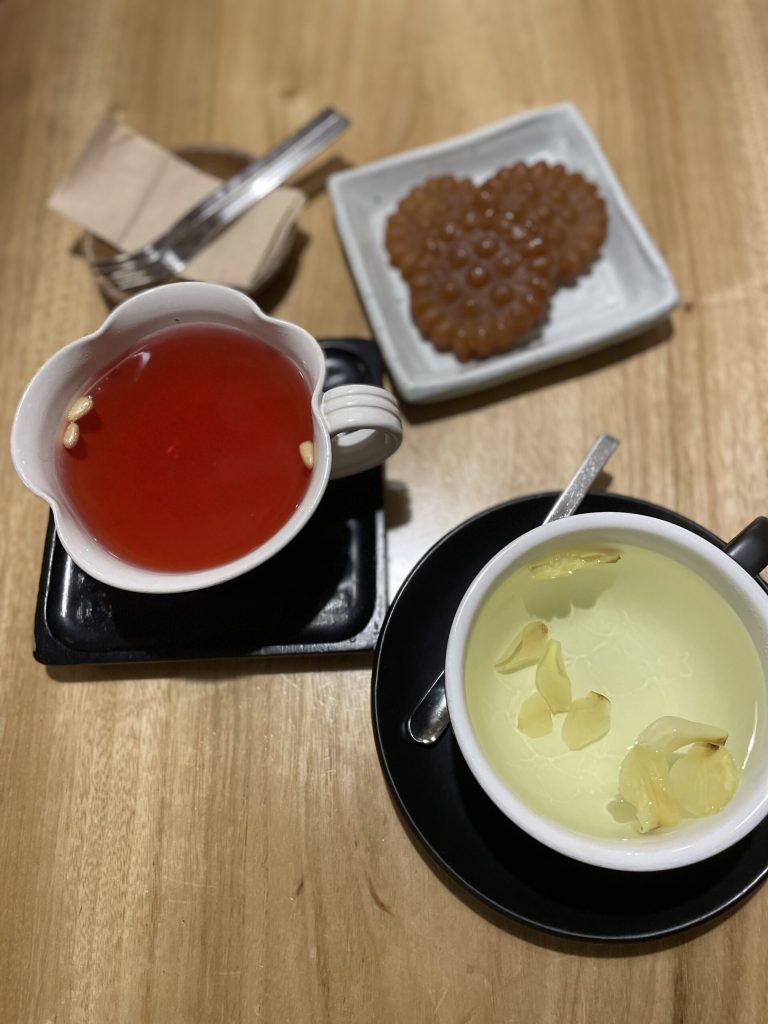The Yakgwa (약과) is a traditional Korean sweet, known for its sweet taste and aromatic fragrance.
Originally considered a dessert and later a pastry product (hangwa) because it has a sweet taste and cookie-like shape, it is actually a type of Yumil-gwa, like Mandu-gwa the sweet fried dumplings whose recipe you can find on the blog.
The word “yakgwa” means “medicinal sweet,” because during the Joseon era, honey was considered a medicine.
In the past, it was prepared for religious ceremonies (a jesa, or ancestral rite), during festive occasions like Chuseok (harvest festival), weddings, or hwangap celebrations (sixtieth birthday).
It is also considered beneficial for health, thanks to the combination of ingredients like honey and sesame oil.
During the Goryeo dynasty (918-1392), yakgwa were also known in China as Goryeo mandu.
Initially, the cookie was shaped like animals or fruits, with added tree twigs to simulate the presence of fruit when it was hard to find fresh ones for the rituals.
Over time, the round shapes, not suitable for stacking and presenting at the table during rites, were replaced by flat ones: its current shape is round with a wavy edge.
The shape is achieved by pressing the dough into wooden molds or flattening it on decorated tiles, greased with sesame oil.
The traditional Yakgwa recipe strictly follows the use of wheat flour, honey, sesame oil, and a frying phase.
Some versions include the use of additional spices like ginseng or samsaekju-type liquor or another fermented beverage (like soju), or the addition of ginger even to the syrup.
The result is a rich and aromatic sweet with a crunchy outside and a soft sweetness inside.
Today, yakgwa is commonly served with tea, as we did during our trip to Seoul, enjoying it in a tea house in the Insa-dong neighborhood.

- Difficulty: Medium
- Cost: Economical
- Rest time: 30 Minutes
- Preparation time: 10 Minutes
- Portions: 12 Pieces
- Cooking methods: Frying
- Cuisine: Korean
- Seasonality: All seasons
Ingredients
- 2 1/3 cups flour
- 1/4 cup honey
- 2 tbsps sesame oil (+ for frying)
- 2 tbsps brown sugar
- 1/2 tsp ginger powder
- to taste toasted sesame seeds (or pine nuts (optional))
- 1/3 cup honey
- 1/4 cup brown sugar (or rice syrup for a lighter version)
- 1 pinch salt
Tools
- 1 Mold Yakgwa
Steps
Mix the wheat flour and sesame oil.
Add honey, brown sugar, ginger powder, and a bit of water (about 1/4 cup) to form the dough. You can also add 2 tablespoons of fermented liquor.The consistency should be soft, but not too sticky.
Work the dough until it becomes elastic and smooth, then let it rest for about 30 minutes.
Take a small portion of dough and form balls, then flatten them into small discs.
With the help of a toothpick or a mold, create the desired shape (flower or rectangles, for example).Fry the Yakgwa in hot sesame oil (at 340-360°F) until they turn golden and crispy. The frying process can last about 4-5 minutes.
Once fried, place the sweets on a plate to cool.For the syrup:
in a pot, combine 150 ml water, honey, and brown sugar.Let the mixture simmer for about 5-7 minutes, until it becomes slightly thick. It should not become too thick, otherwise, it will crystallize once cooled.
Add a pinch of salt to balance the sweetness.
Dip the fried Yakgwa into the syrup.
Let it sit for a few minutes until the syrup is absorbed, then transfer the cookies to a clean plate.
Immediately sprinkle the surface with sesame or chopped pine nuts, serve.N.B. Traditionally, Yakgwa are not sprinkled with sesame or pine nuts.
During our trip, we also bought mini Yakgwa – which you can also find on line – which you can see in the photo:

Curiosities:
The success of yakgwa was such that the government had to issue decrees for fear of a shortage of its main ingredients, such as flour, honey, and oil.
The rulers of the Goryeo dynasty, particularly King Myeongjong (1131-1202) and King Gongminwang (1330-1374), went as far as to prohibit common people from making Yakgwa, pushing people to opt for fruit-based snacks.
The restrictions continued during the Joseon dynasty (1392-1910), where common citizens caught consuming sweets, on occasions other than weddings, festivities, or rites, risked severe punishments.
These restrictive laws did not apply to noble and wealthier families.
Despite the high cost of raw materials, Yakgwa established itself as an indispensable food for festivities, banquets, and ancestral rites, continuing to be present on the tables of special occasions throughout the country.
FAQ (Frequently Asked Questions)
What is a Yumil-gwa?
Yumil-gwa (Korean: 유밀과 ; Hanja: 油蜜菓) is a variety of hangwa, a traditional Korean sweet.
Different varieties of yumil-gwa can be made by combining a wheat flour dough with various ingredients such as: honey, oil, cinnamon, nuts, ginger juice, jujubes, and cheongju (rice wine).
The word yumil-gwa is composed of three syllables: yu (유 ;油) meaning “oil“, mil (밀 ;蜜) meaning “honey” and gwa (과 ;菓) meaning “confection“.
The dough for yumil-gwa is made by kneading sifted wheat flour with sesame oil, honey, ginger juice, and cheongju (rice wine).
Additional ingredients for filling and garnish may include cinnamon powder, honey, jujubes, and pine nuts.
Fried yumil-gwa is dipped in honey or jocheong (rice syrup) and dried.How do I get the typical flower shape of yakgwa?
You can use a Yakgwa mold in silicone, wood, or even cast iron.
For the silicone mold, about 1 oz of dough is perfect. Brush the mold first with a little sesame oil, then push the dough into the mold.
Press gently and evenly with the palms of your hands.
Then detach the yakgwa cookie from the mold and set it aside.
If you don’t have a mold, roll out the dough, then cut it into squares, diamonds, or you can also use a cookie cutter.

